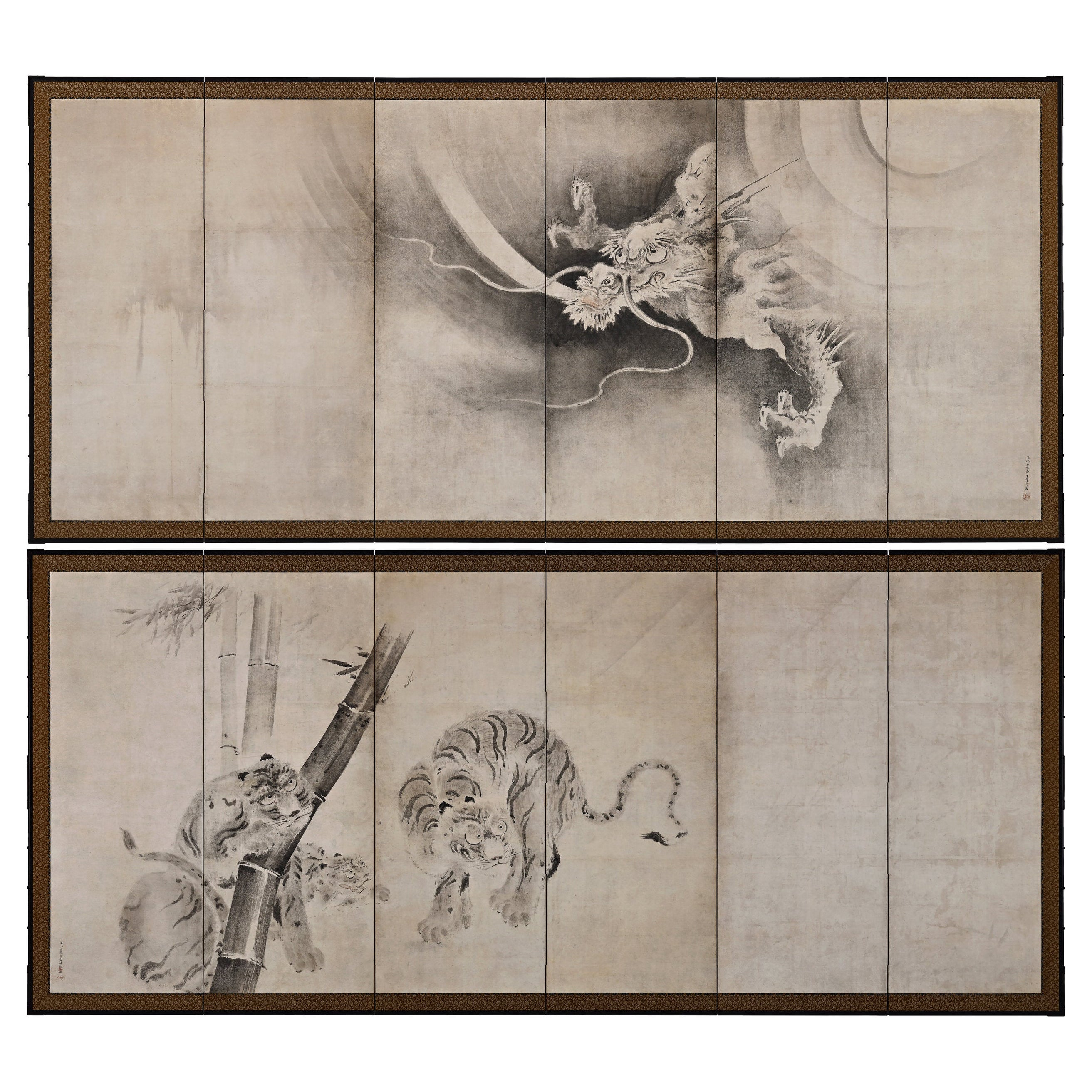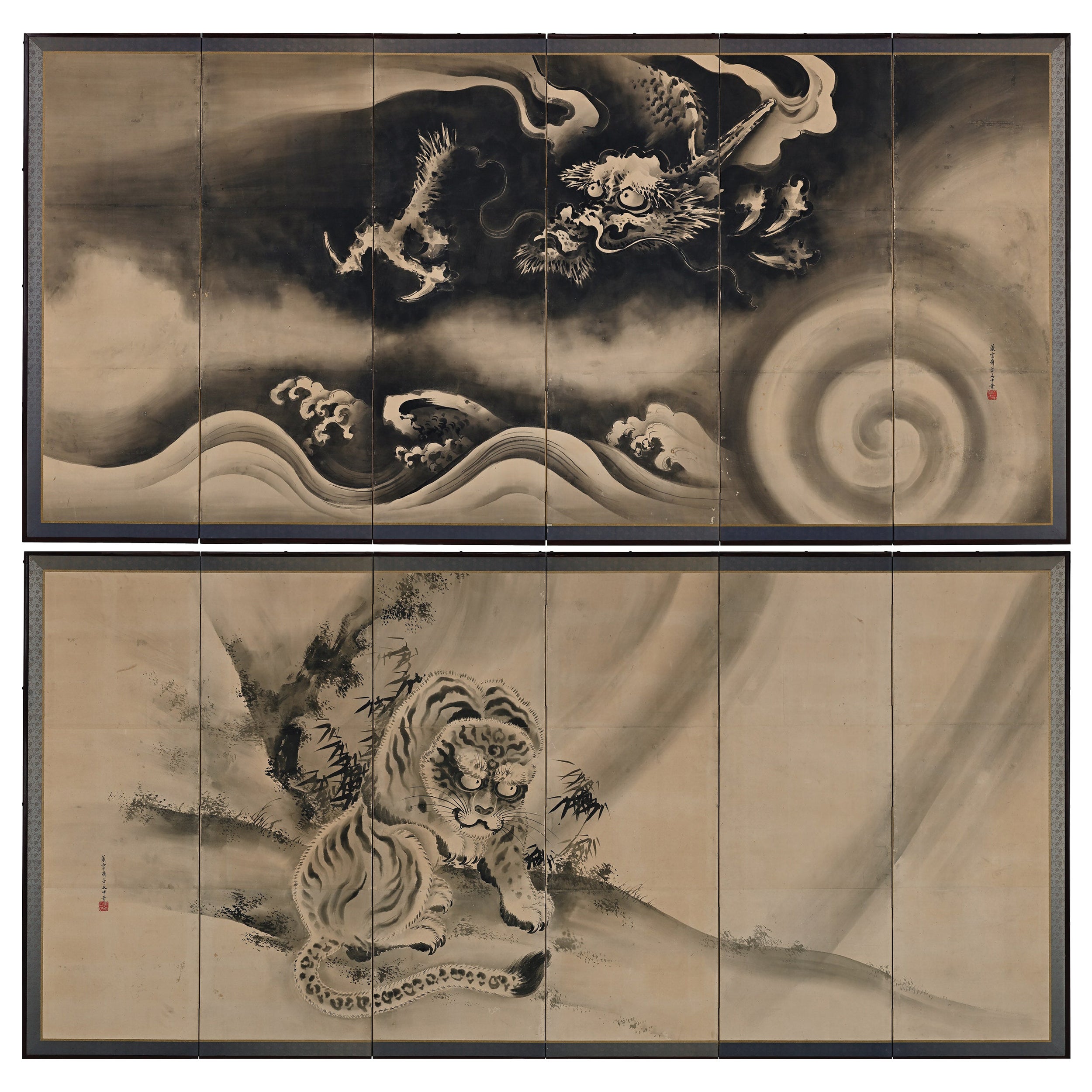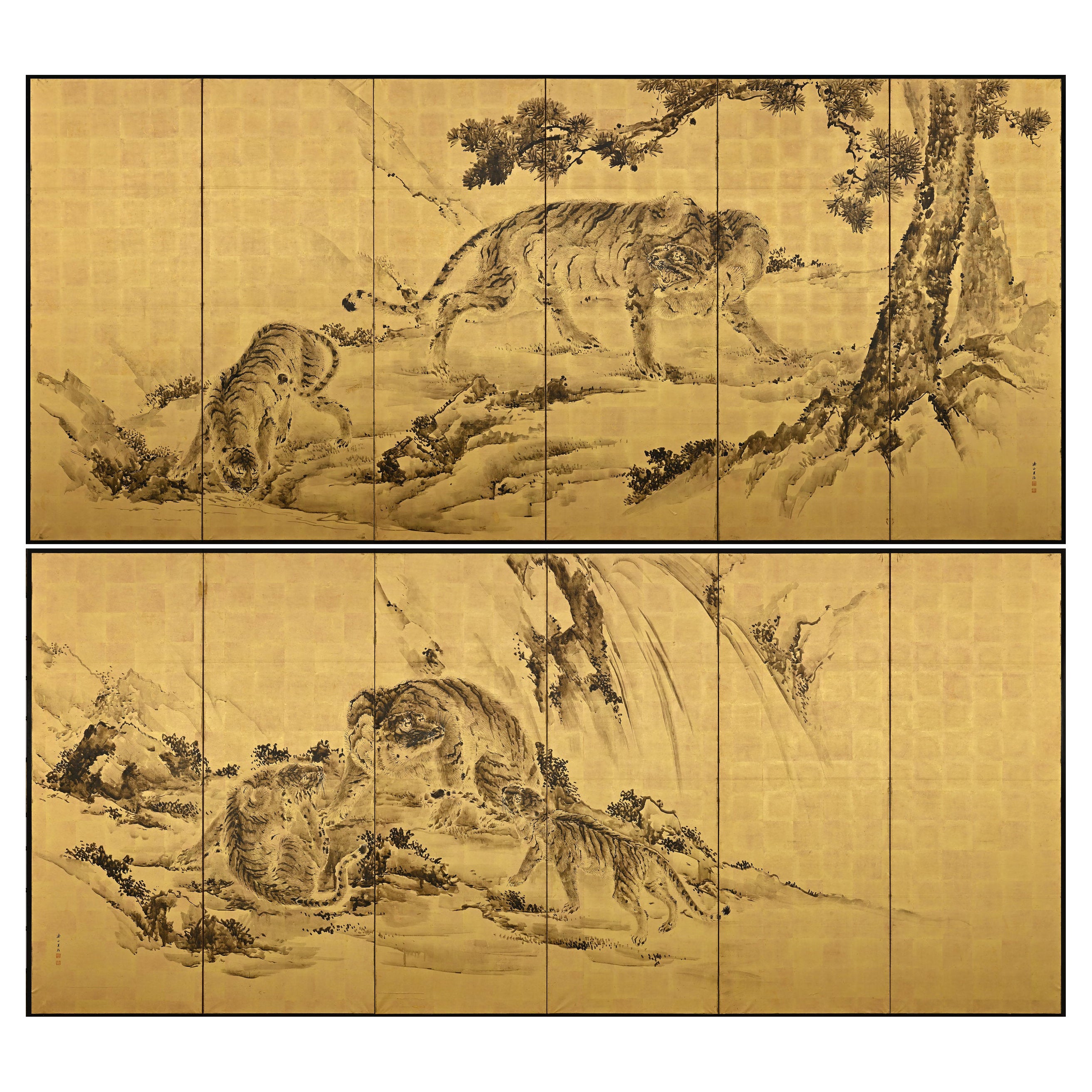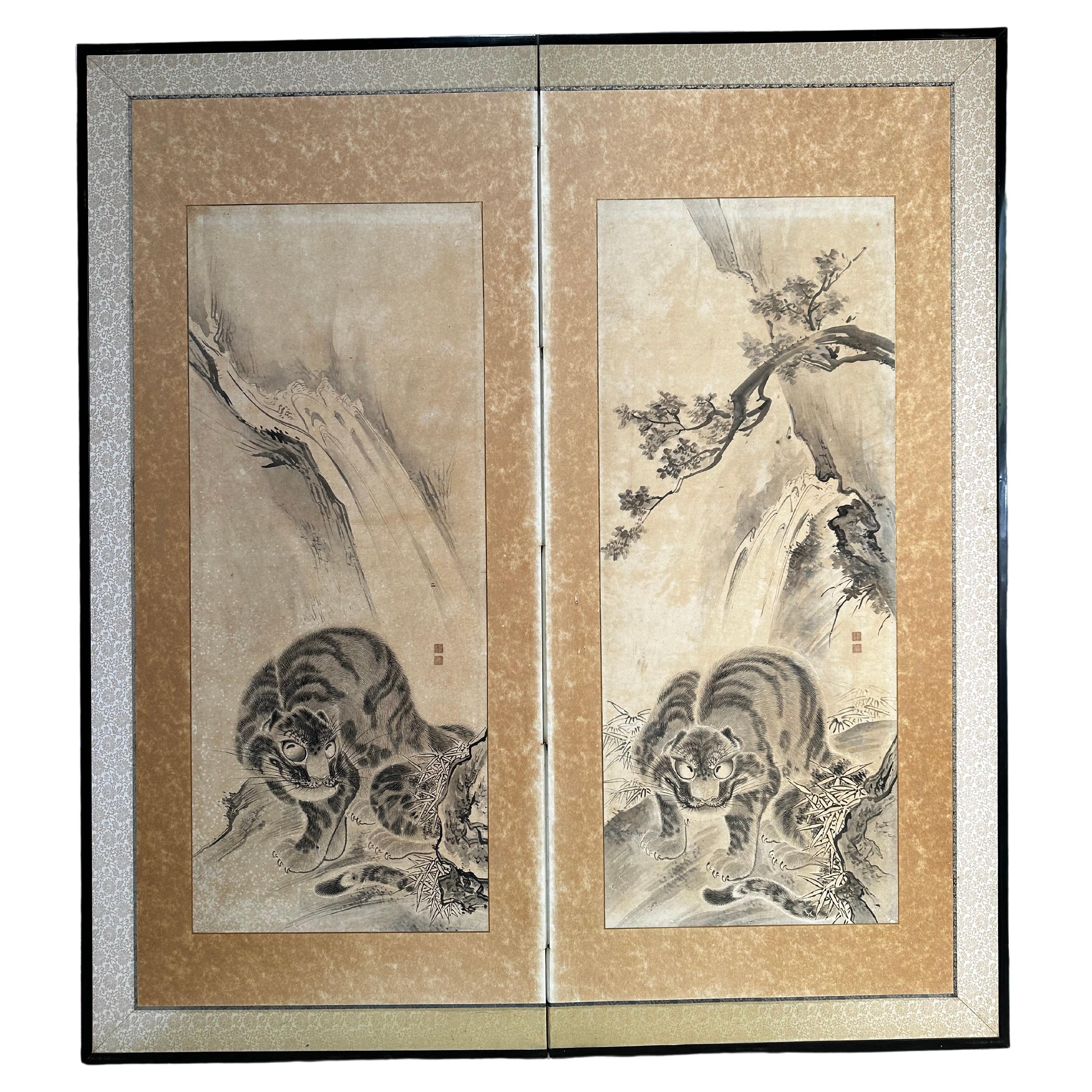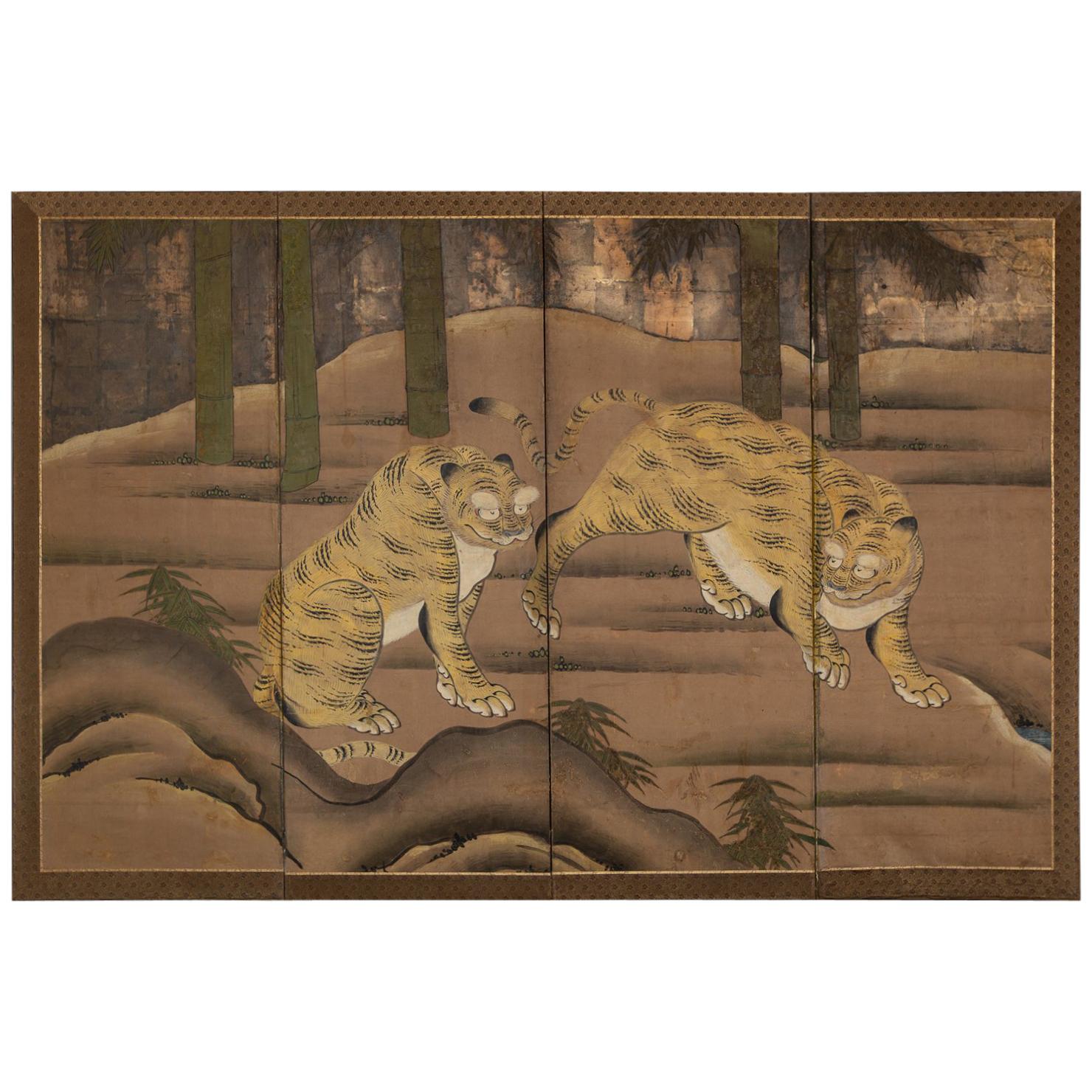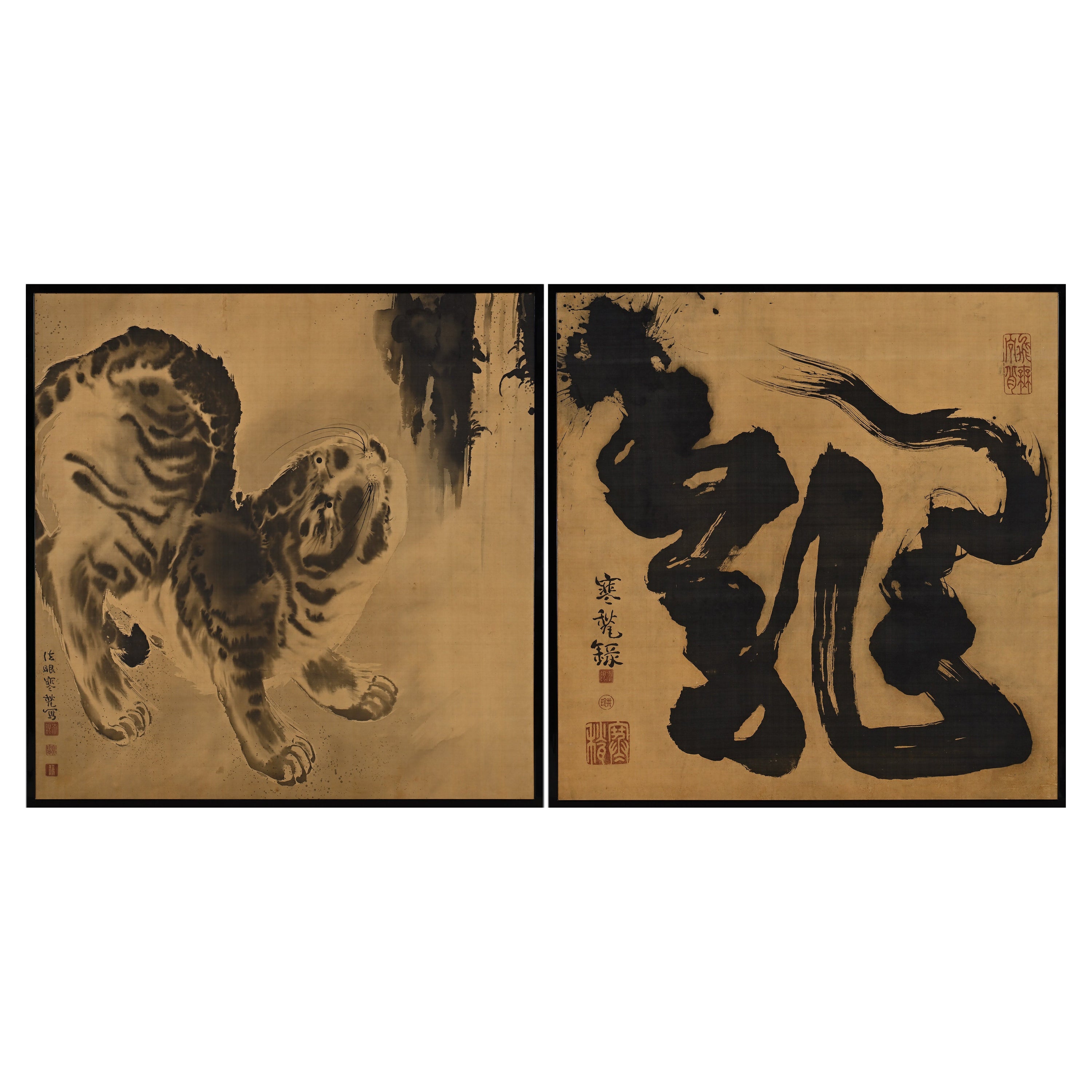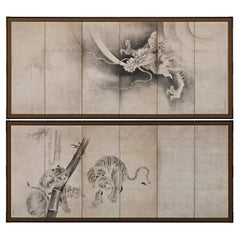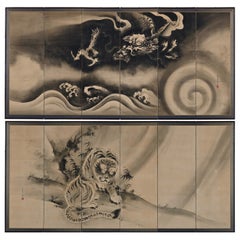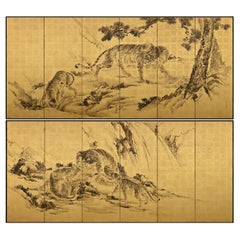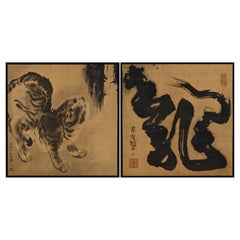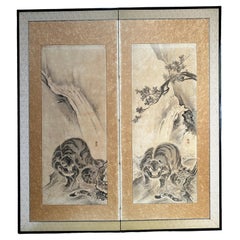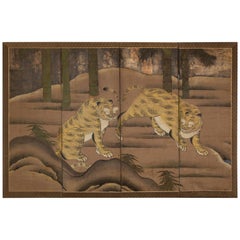Artículos similares a Edo period Japanese Screen. Tiger and Pine by Kishi Ganku.
¿Quieres más imágenes o vídeos?
Solicita imágenes o vídeos adicionales al vendedor
1 de 7
Edo period Japanese Screen. Tiger and Pine by Kishi Ganku.
24.657,10 €
Acerca del artículo
Kishi Ganku (1749/1756-1838)
Tiger and Pine
A six-panel Japanese Screen. Ink on silver leaf.
The central focus of this Japanese screen is a large tiger, emerging from shadow, crouched beneath an ancient pine tree. The pine branches extend diagonally across the upper portion, creating a dynamic counterbalance to the grounded, muscular form of the tiger below. Sparse foliage and misty emptiness in the background emphasize the negative space, allowing the tiger and trees to dominate. The angled ink washes, slanting from the upper left toward the lower right, mimic the invisible force of wind sweeping through the landscape. They energize the composition and draw the viewer’s eye in a sweeping motion. The tiger has been associated with the earth and wind since ancient times, much as its counterpart, the dragon, has been associated with the heavens and rain. The entire background is covered with silver leaf, creating a luminous and atmospheric backdrop. Over time, the silver has oxidized, giving it a mottled, antique appearance of reflective silver, muted grays and copper browns. The oxidized silver leaf is a dynamic and reactive surface that changes dramatically in color and appearance depending on lighting conditions and angle of view.
Kishi Ganku (1749/1756-1838) is an artist whose birth year and birthplace are shrouded in mystery. He is said to have been born in either Kanazawa or Toyama, but he spent his childhood and youth in Kanazawa. After moving to Kyoto, he was discovered by Prince Arisugawa and served him, building connections with the Imperial Court and nobles. He produced paintings for the sliding doors of the Imperial Palace and Kanazawa Castle, and received many requests from feudal lords around the country. The Kishi school became a major force in Kyoto, alongside the Maruyama Shijo school. Ganku’s paintings of tigers were particularly popular. He was so skilled at painting tigers that he was nicknamed "Kishikoma no Tora. He was made honorary governor of Echizen (Echizen no kami, 越前守) toward the end of his life.
Initially, Ganku studied Kano style painting but early in his studies he shifted to explore the meticulous Nanpin style named for the Chinese painter Shen Nanpin (active early 18th century). Following his study of Nanpin, he explored Japanese naturalism under Maruyama Okyo, and Chinese-inspired naturalism under Matsumura Goshun of the Shijo school in Kyoto. Perhaps unsatisfied with any of these popular styles, he founded his own school, the Kishi school, characterized by a rough and vigorous brush style but still reflective of the many influences his training had provided.
- Dimensiones:Altura: 441,96 cm (174 in)Anchura: 370,84 cm (146 in)Profundidad: 1,91 cm (0,75 in)
- Estilo:Edo (Del período)
- Materiales y técnicas:
- Lugar de origen:
- Época:
- Fecha de fabricación:Circa 1800
- Estado:Refinado. Desgaste acorde con la edad y el uso. The screen was most recently re-mounted approximately 20 years ago.
- Ubicación del vendedor:Kyoto, JP
- Número de referencia:1stDibs: LU2472345369062
Sobre el vendedor
5,0
Vendedor reconocido
Estos prestigiosos vendedores son líderes del sector y representan el escalón más alto en cuanto a calidad y diseño de artículos.
Establecido en 2001
Vendedor de 1stDibs desde 2016
70 ventas en 1stDibs
Tiempo de respuesta usual: 6 horas
- EnvíoRecuperando presupuesto…Envío desde: Kyoto, Japón
- Política de devolución
Partes de esta página se han traducido automáticamente. 1stDibs no puede garantizar la exactitud de las traducciones. El inglés es el idioma predeterminado de este sitio web.
Garantía de autenticidad
En el improbable caso de que haya algún problema con la autenticidad de un artículo, ponte en contacto con nosotros en un plazo de 1 año para recibir un reembolso total. DetallesGarantía de devolución de dinero
Si tu artículo no es como se describe, sufre daños durante el transporte o no llega, ponte en contacto con nosotros en un plazo de 7 días para recibir un reembolso total. DetallesCancelación dentro de las 24 horas
Tienes un período de gracia de 24 horas para reconsiderar tu compra, sin preguntas.Vendedores profesionales aprobados
Nuestros vendedores de primera clase deben cumplir estrictos estándares de servicio para mantener la integridad de nuestros anuncios.Garantía de igualación de precios
Si encuentras que un vendedor publicó el mismo artículo por un precio menor en otro lado, igualaremos ese precio.Entrega global de confianza
Nuestra red de transporte de primera ofrece opciones de envío especializado en todo el mundo, que incluye envío personalizado.Más de este vendedor
Ver todoPareja de biombos japoneses del siglo XVII. Tigre y Dragón de Kaiho Yusetsu
Kaiho Yusetsu (1598-1677)
Tigre y Dragón
Principios del periodo Edo, hacia 1650
Un par de biombos japoneses séxtuples. Tinta y ligero color sobre papel.
Dimensiones:
C...
Categoría
Antiguo, mediados del siglo XVII, Japonés, Edo, Pinturas y biombos
Materiales
Seda, Madera, Papel
Pareja de biombos japoneses del siglo XIX. Tigre y Dragón de Tani Bunchu.
Tani Bunchu (1823-1876)
Tigre y Dragón
Un par de pantallas japonesas de seis paneles. Tinta sobre papel.
En este gran par de pantallas japonesas Ryuko-zu, el tigre se agacha hasta...
Categoría
Antiguo, Mediados del siglo XIX, Japonés, Edo, Pinturas y biombos
Materiales
Madera, Papel
Pareja de biombos japoneses, Tigres de Kishi Renzan, Periodo Edo tardío
Kishi Renzan (1804-1859)
Tigres
Pareja de biombos japoneses de seis paneles.
Tinta y pan de oro sobre papel.
En este par monocromático de biombos japoneses séxtuples pint...
Categoría
Antiguo, Mediados del siglo XIX, Asiático, Edo, Pinturas y biombos
Materiales
Hoja de oro
Pinturas japonesas del siglo XIX. Zenga Tigre y Dragón de Inoue Kanshu.
Inoue Kanshu (1807-1880)
Tigre y Dragón Zenga
siglo XIX
Pareja de cuadros japoneses enmarcados. Tinta sobre seda.
Dimensiones (cada una): An. 114 cm x Al. 115 cm (45" x 45")
Aqu...
Categoría
Antiguo, Mediados del siglo XIX, Japonés, Meiji, Pinturas y biombos
Materiales
Seda
Biombo japonés, circa 1700 "Cuentos de Ise", de Tosa Mitsusuke
Por Tosa Mitsusuke 1
Biombo japonés de Tosa Mitsusuke (1675-1710), Japón, siglos XVII-XVIII, periodo Edo.
La firma reza Shoroku-i ge Tosa sa Konoe Shogen Mitsusuke Hiitsu. El sello es ilegible.
Tinta, ...
Categoría
Antiguo, finales del siglo XVII, Japonés, Edo, Pinturas y biombos
Materiales
Hoja de oro
Biombo japonés del siglo XVII. Vista del Lago Oeste por Unkoku Toyo.
Unkoku Toyo (1612-1668)
Vista del Lago Oeste
Pareja de biombos japoneses de ocho paneles. Tinta y aguada dorada sobre papel.
Dimensiones: Cada pantalla: H. 110 cm x A. 372 cm (43"...
Categoría
Antiguo, mediados del siglo XVII, Japonés, Edo, Pinturas y biombos
Materiales
Papel
También te puede gustar
Biombo de Tigre de la Escuela de Nagasaki del Siglo XVIII
Biombo de Tigre de la Escuela de Nagasaki del Siglo XVIII
Periodo: Edo
Tamaño: 165 x 172 cm (65 x 67,7 pulgadas)
SKU: PTA69
Este excepcional biombo del siglo XVIII, perteneciente a...
Categoría
Antiguo, principios del siglo XVIII, Japonés, Edo, Pinturas y biombos
Materiales
Madera, Papel
Biombo japonés de cuatro paneles: Dos Tigres
Dos tigres intercambiando miradas amorosas. Pintura de la Escuela de Kano.
Categoría
Antiguo, siglo XVIII, Japonés, Pinturas y biombos
Materiales
Papel
B13 Japanese Antiques 2panels, silk, folding Screen with Tiger
Material: Silk on wooden frame
One piece: W685×H1525mm×D20mm,
Unfolded size: W1370mm
Folded size: W685×H1525×D40mm, 5kg
Packaging (sandwiched with 5mm plywood): 10cm x 77cm x 160cm, ...
Categoría
siglo XX, Japonés, Pinturas y biombos
Materiales
Seda
Pintura de finales del siglo XIX (periodo Meiji) que representa un tigre
Antiguo Cuadro Tigre sobre Papel - Periodo Meiji
Sorprendente representación de un tigre, pintada sobre papel y firmada por el artista. Esta obra formaba parte originalmente de un b...
Categoría
Antiguo, Fines del siglo XIX, Japonés, Meiji, Pinturas y biombos
Materiales
Hoja de oro
Gran pergamino japonés de un tigre
Tigre maravillosamente grande y audaz pintado en tinta y pigmentos minerales sobre seda montada con borde de brocado de seda. En el sello se lee: Miyaguchi (lectura alternativa: Sona...
Categoría
Antiguo, Principios del 1800, Japonés, Edo, Pinturas y biombos
Materiales
Seda
Pintura japonesa sobre lino de Tigre rugiente
Pintura japonesa en acuarela y tinta sobre lino fino, montada en marco de madera con acabado rojo ladrillo y mate forrado de dorado, firmada en la ...
Categoría
siglo XX, Japonés, Pinturas y biombos
Materiales
Lino
